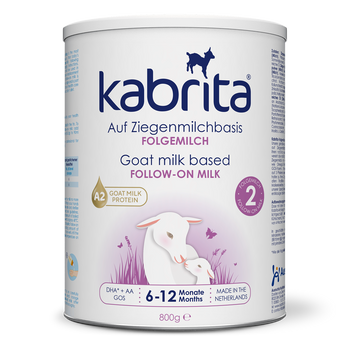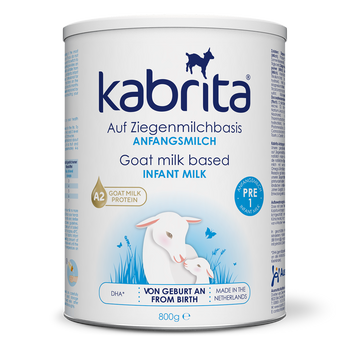FAQ Category: Ailments
No, if someone is allergic to cow’s milk it is very likely that there will also be an allergic reaction to goat milk. A cow’s milk allergy is mediated by the protein from cow’s milk. Although the protein from goat milk are different and contain less allergens, it is still very likely that a cross reaction will occur. Therefore we strongly advise against using goat milk as an alternative in case of a cow’s milk allergy.
A medically confirmed cow's milk allergy is the most common food allergy in infants (between 2% and 5% of babies and young children [1]), while there is a much larger group that experiences discomfort after consuming cow’s milk products. These consumers may suffer from a so-called cow’s milk intolerance where components in the milk – either the fat, protein, or a combination of components – are digested poorly. These consumers are likely to benefit from a switch to goat milk based nutrition.
[1] Pensabene, L.; Salvatore, S.; D’Auria, E.; Parisi, F.; Concolino, D.; Borrelli, O. Cow’s Milk Protein Allergy in Infancy: A Risk Factor for Functional Gastrointestinal Disorders in Children? Nutrients 2018, 10, 1716. [CrossRef] [PubMed]
Cow milk allergy and cow milk or lactose intolerance are different disorders. The names are sometimes incorrectly used as the similar symptoms they cause are often confused.
In the case of a (medically) confirmed cow milk allergy, the immune system responds immediately to the protein in cow milk. However, a medically confirmed allergy to cow milk is relatively rare (2 to 3% of children under the age of six). This usually happens within hours of ingestion and results in moderate to severe symptoms, which can include:
- Swelling around the mouth
- Difficulty swallowing
- Vomiting and regurgitation
- Severe diarrhoea
- Food refusal
- Failure to thrive (insufficient weight gain)
- Severe colic
In rare cases, anaphylactic shock leading to death
With mild complaints due to hypersensitivity to cow milk, goat milk could possibly be a gentle alternative. These mild complaints are often called a cow milk intolerance. A cow milk intolerance can occur when components of cow milk – the fat, protein, or a combination of components – are digested poorly. Unlike a cow milk allergy, a cow milk intolerance is not a medical condition. It can however lead to mild to moderate symptoms that can affect the skin, gastrointestinal, and respiratory systems. These symptoms can take days, weeks or even months to present and can include:
- Mild to moderate eczema
- Nappy rash
- Abdominal discomfort
- Gas
- Bloating
- Constipation
- Loose stools
- Colic
- Lung and nasal congestion
A lactose intolerance causes symptoms due to poorly digested lactose. Lactose is present in all milk produced by mammals (including humans) and is often referred to as milk sugar. As breast milk also naturally contains lactose, it is very unlikely that your baby or toddler will be lactose intolerant. In many cases, poor lactose digestion occurs after weaning. It may lead to the symptoms as described below and is, in that case, referred to as lactose intolerance:
- Abdominal bloating and cramps
- Flatulence
- Diarrhoea
- Nausea
- Rumbling stomach
- Vomiting
In case of complaints always consult your doctor first - or the health professional at the child health clinic- to rule out a cow milk allergy or lactose intolerance, before switching to Kabrita goat milk formula.
Kabrita's goat milk products all contain milk. The formulation of the products may differ per country and may contain fish oil and/or soy. Always check the packaging for specific information about allergens in the product.
Yes, Kabrita goat milk formula contains lactose. Lactose is an important source of carbohydrates that deliver the necessary energy for the healthy growth and development of your baby or toddler. Lactose can be found in almost all milk produced by mammals; including breast milk. A lactose intolerance causes symptoms due to poorly digested lactose. As breast milk also naturally contains lactose, it is very unlikely that your baby or toddler will be lactose intolerant.
To ensure that babies and toddlers are given enough carbohydrates, the minimum amount of lactose that a formula must contain has been established in the European legislation on infant formula.
In case of complaints always consult your doctor first - or the health professional at the child health clinic- to rule out a lactose intolerance, before switching to Kabrita goat milk formula.
Yes, goat milk contains lactose; about 10% less than cow milk. Lactose can be found in almost all milk produced by mammals; including breast milk. A lactose intolerance causes symptoms due to poorly digested lactose.
Yes, a change in the consistency, colour and/ or frequency of stools is normal after starting to give solid food or after a change in the formula.
Yes, a change in the consistency, colour and/ or frequency of stools is normal after starting to give solid food or after a change in the formula.
Reflux occurs when food backs up (refluxes) from the stomach. A regularly seen symptom of reflux is that the baby brings up milk, or solids, during or shortly after feeding.
Reflux is a common complaint with babies. Reflux is caused in infants by an insufficiently mature ring of muscle between the oesophagus and the stomach. This ring of muscle develops during the first year of life and in most cases the symptoms will decrease or disappear.





